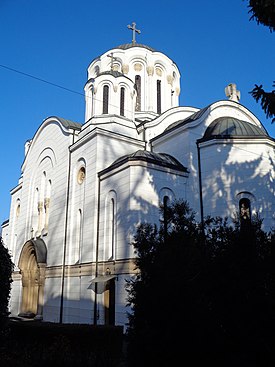Vavedenje Monastery
This article needs additional citations for verification. (September 2021) |
| Vavedenje Monastery | |
|---|---|
Манастир Ваведење | |
 | |
 | |
| Denomination | Serbian Orthodox |
| Architecture | |
| Architectural type | Serbo-Byzantine architecture |
| Style | Serbo-Byzantine style |
Vavedenje Monastery (Serbian Cyrillic: Манастир Ваведење) is a Serbian orthodox monastery located in Senjak, an urban settlement in the municipality of Savski venac in Belgrade. The foundations of the temple were consecrated on August 11, 1935.[1] It was built and consecrated on October 25, 1936[2] as the metochion of Kuveždina Monastery in Srem. The legend of the construction of the church is related to the dream of the founder Perside Milenković, who fell asleep three times, that the monastery should be built on that very spot. The boarding house, built at the same time as the church, was said to be used as a boarding school for the education of Orthodox charitable sisters, educators and caregivers before its completion.[3]
In 1939, there were ten nuns in the monastery[4] doing embroidery work, such as making veils for the table of honor and curtains for the patriarchal chapel.[5]
The Holy Confessor Dositej Vasić was buried in the gate and in 2009 he was transferred to the ark of the monastery temple. It represents an immovable cultural property as a cultural monument. Serbian archbishops Damaskin Grdanički, Arsenije Bradvarević, Josif Cvijović and Danilo Krstić were also buried in the monastery.
The abbots of the Vavedenja monastery were: Melanija Krivokućanin (1938—1942), Angelina Gračeva (1942—1970), Agnija Dmitrović (1980—2001), Anastasija Savković (2001—2019), Teodora Vasić (2020—present).[6]
The priests in the monastery are Archpriest Fr. Milovan Glogovac and Fr. Milosav Radojevic. In the residence of the Vavedenja monastery, there is a chapel – a winter church dedicated to St. Nicholas the Wonderworker. In the chapel there are three arks with particles of the relics of the saints. There is also a pillow on which the head of St. Petka rested in the ark in Iasi, which the sisters received as a gift from a monk from Iasi. The monastery treasury keeps old manuscripts and printed liturgical books, as well as icons that Russian nuns brought with them to Serbia after the October coup. On the territory of the monastery complex, there are three pits in which the bodies of those killed and shot on St. Dmitrov's Day in 1944 and those who died on Easter 1944 from the Allied bombing are.
Complex architecture

The monastery and the introduction[clarification needed] consists of the church dedicated to the Holy Mother of God and konak, built according to the plans of the architects Ivan Rik and Petra Popović, some of the first developers of the Serbian national style in contemporary Serbian architecture.
The base of the church is in the shape of an inscribed cross, with a central dome at the intersection and four smaller domes between the arms of the cross. The five-domed solution indicates the models are taken from Serbian medieval architecture from the 14th century. In the eastern part of the temple there is a spacious, semicircular inside, five-sided outside apse, from which one enters the side rectangular rooms – deacon and proskomidia, while in the west narthex with the choir. Out of a total of three portals, the one on the western façade with a wide access staircase is the most luxuriously treated. The main decorative decoration of the façade consists of narrow one-piece [windows], rosettes and large triforas on the north and south sides.
The masonry altar partition has the usual arrangement of icons, and the wall paintings made in the al seco technique are the work of the academic painter Dušan Mihailović from the period 1973–1985. Now,[as of?] the painting of the temple with a new fresco is nearing completion. In addition to its architectural values, the church of the Vavedenja monastery is a successful example of connecting sacred buildings with the modern development of the city and its surroundings.
See also
References
- ^ "Време". 12 August 1935. Archived from the original on 2021-09-05.
- ^ "Политика". 26 October 1936. Archived from the original on 2021-09-05.
- ^ "Политика", 29. април 1936
- ^ Православни женски манастир у Београду, Време, 26. нов. 1939, стр. 13. digitalna.nb.rs (приступ. 26.11.2019)
- ^ "Политика", 26. феб. 1939
- ^ "Историјат обитељи манастира Ваведења Пресвете Богородице – Манастир Ваведење – Београд" (in Serbian). Retrieved 2020-05-09.
